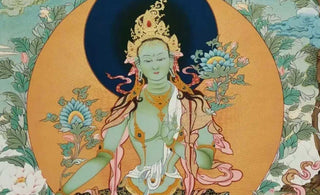
Introduction:
Green Tara, a prominent figure in Tibetan Buddhism, holds profound significance in the realms of ideology, theology, and philosophy. As a revered deity, she embodies the compassionate and enlightened qualities that practitioners aspire to cultivate. This exploration delves into the symbolism of Green Tara, shedding light on her role in Tibetan Buddhism and the multifaceted meanings attributed to her.
1. Ideological Significance:
In Tibetan Buddhism, Green Tara represents the embodiment of enlightened activity. Her green color symbolizes youthful vigor and the flourishing of spiritual growth. Ideologically, Tara is often associated with the compassionate aspect of enlightenment, emphasizing the altruistic intention to liberate all beings from suffering. The ideological underpinnings of Green Tara's symbolism thus underscore the interconnectedness of compassion and enlightenment in the Tibetan Buddhist worldview.
2. Theological Insights:
The thangka pendant becomes a visual conduit for conveying intricate theological concepts. Green Tara, as a Bodhisattva, is depicted in a posture that radiates compassion and enlightened activity. The pendant's artistic rendition reflects the devotion and skill of the painter, translating theological abstractions into a tangible and accessible form. The gold outline, a symbol of purity and transcendence, adds an ethereal touch, elevating the representation beyond mere artistic expression.
Within the intricate tapestry of Tibetan Buddhist theology, Green Tara occupies a central place. She is considered a Bodhisattva, a being dedicated to attaining Buddhahood for the benefit of all sentient beings. Tara's feminine manifestation challenges traditional gender norms in religious iconography, embodying the concept that enlightenment transcends gender. Theologically, Green Tara is also associated with the concept of "emptiness" (shunyata), a fundamental tenet in Mahayana Buddhism, highlighting the transcendent nature of reality.
Every brushstroke on the pendant contributes to a rich tapestry of symbolism. Tara's feminine manifestation challenges traditional gender norms, a symbolism mirrored in her depiction as a compassionate and enlightened figure. The pendant, through its artistic rendering, invites contemplation on the transcendent nature of gender and the universality of enlightenment. The "emptiness" (shunyata) associated with Green Tara is not merely a theological concept but a visual motif, inviting the observer to explore the profound depths of reality through art.
The meticulous hand-painting of the pendant underscores the craftsmanship and devotion invested in its creation. Each stroke is a labor of love, reflecting the artist's commitment to portraying Green Tara with precision and reverence. This level of detail enhances the pendant's significance, as it becomes not just a piece of jewelry but a sacred object infused with the energy of the artisan's spiritual practice.
3. Divine Attributes:
Green Tara is revered for her divine attributes, each carrying symbolic significance. Her right hand is often depicted in the gesture of supreme generosity (varada mudra), symbolizing her readiness to assist and fulfill the wishes of devotees. The left hand, in the gesture of protection (abhaya mudra), signifies her commitment to shielding beings from fear and suffering. The lotus flower she sits upon symbolizes purity and the potential for enlightenment, while her posture reflects meditative stability. Understanding these divine attributes deepens the symbolism of Green Tara within the context of Tibetan Buddhist worship.
4. Relationship with Other Deities:
In the pantheon of Tibetan Buddhist deities, Green Tara shares intricate relationships with other divine figures. She is often invoked alongside Avalokiteshvara, the Bodhisattva of compassion, emphasizing the synergistic nature of compassion and enlightened activity. Exploring these interconnections reveals the intricate web of relationships within Tibetan Buddhism, illustrating how different deities complement each other in guiding practitioners on the path to enlightenment.
5. Cultural and Symbolic Representations in Tibet:
The gold outline, delicately tracing the contours of Green Tara, holds profound symbolism. In Tibetan Buddhism, gold is associated with purity, enlightenment, and the transcendent nature of the divine. The gold outline on the pendant, therefore, serves as a visual representation of Tara's enlightened essence. It accentuates the sacredness of the image and reinforces the idea that Green Tara transcends the limitations of the material world.
Beyond the theological and philosophical realms, Green Tara's symbolism is deeply ingrained in Tibetan culture. The imagery of Green Tara is found in thangkas, murals, and sculptures adorning monasteries and homes. The vibrant green hue not only represents the lush landscapes of Tibet but also symbolizes fertility and abundance. The folkloric narratives surrounding Green Tara contribute to the rich tapestry of Tibetan cultural heritage, intertwining spirituality with daily life.
Conclusion:
The symbolism of Green Tara in Tibetan Buddhism extends far beyond mere iconography; it encapsulates profound ideological, theological, and philosophical dimensions. Her representation as a compassionate and enlightened deity serves as a guiding light for practitioners navigating the path to liberation. In understanding Green Tara's symbolism, one gains insights into the core tenets of Tibetan Buddhism and the intricate interplay of compassion, enlightenment, and cultural expression within this spiritual tradition.

Green Tara Tibetan Thangka Pendant Hand-painted with Gold Outline























